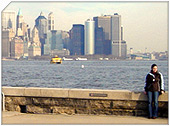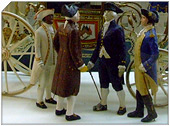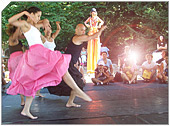Getting Started
Index
NYC Neighborhoods
Manhattan
Brooklyn
Queens
Bronx
Staten Island
NYC Icons
Chrysler Building
Flatiron Building
Empire State Building
Safe NYC
NYPD
FDNY
NYC Weather
NYC Climate
NYC Weather Forecast
Winter Season
Spring Season
Summer Season
Fall Season
NYC History & Politics
New York City History
Tammany Hall and Politics
New York City Politicians
New York City Personalities
Culture of Gotham City
Culture of the city
Cultural diversity
City in popular culture
|
The Hudson River, called Muh-he-kun-ne-tuk in Mahican, is a river that runs through the eastern portion of New York State and, along its southern terminus, demarcates the border between the states of New York and New Jersey. It is named for Henry Hudson, an Englishman sailing for the Dutch East India Company, who explored it in 1609. Hudson originally named the river the Mauritius River in honor of Prince Maurice of Nassau. Early European settlement of the area clustered around the river. The area inspired the Hudson River school of painting, a sort of early American pastoral idyll.
Geography
The official source of the Hudson is Lake Tear of the Clouds in the Adirondack
Mountains. However, the waterway from the lake is known as Feldspar
Brook and the Opalescent River, feeding into the Hudson at Tahawus.
The actual Hudson River begins several miles north of Tahawus
at Henderson Lake. The Hudson is joined at Troy (north of Albany)
by the Mohawk River, its major tributary, just south of which
the Federal Dam separates the Upper Hudson River Valley from
the Lower Hudson River Valley or simply the Hudson River Valley.
South of Troy, the Hudson widens and flows south into the Atlantic
Ocean between Manhattan Island and the New Jersey Palisades,
forming New York Harbor, at New York Bay, an arm of the Ocean.
The Hudson was originally named the "North River" by the Dutch,
who named the Delaware River the "South River." This name persists
to this day in radio communication among commercial shipping
traffic, as well as place names such as the North River Sewage
Treatment Plant. It was the English who originated the Hudson
name, even though Hudson had found the river while exploring
for the Dutch.
The lower Hudson is actually a tidal estuary, with tidal influence extending as far as the Federal Dam at Troy. Strong tides make parts of New York Harbor difficult and dangerous to navigate. During the winter, ice floes drift south or north, depending upon the tides. The Mahican name of the river, Muh-he-kun-ne-tuk, means "the river that flows both ways." The Hudson is often mistaken for one of the largest rivers in the United States, but it is an estuary throughout most of its length below Troy and thus only a small fraction of water, about 15,000 cubic feet (425 m³/s) per second, is present. The mean freshwater discharge at the river's mouth in New York is approximately 21,400 cubic feet (606 m³) per second.
The Hudson and its tributaries-notably the Mohawk River-drain a large area. Parts of the Hudson river form coves, such as Weehawken Cove in Hoboken and Weehawken.
The Hudson is sometimes called a "drowned" river. The rising sea levels after the retreat of the Wisconsin glaciation, the most recent ice age, have resulted in a marine incursion that drowned the coastal plain and brought salt water well above the mouth of the river. The deeply-eroded old riverbed beyond the current shoreline, Hudson Canyon, is a rich fishing area. The former riverbed is clearly delineated beneath the waters of the Atlantic Ocean, extending to the edge of the continental shelf.
Notable landmarks on the Hudson include West Point, the Culinary Institute of America, Marist College, Bard College, the Thayer Hotel at West Point, Bannerman's Castle, Metro-North Railroad's Hudson Line (formerly part of the New York Central Railroad system), The Tappan Zee, the New Jersey Palisades, Hudson River Islands State Park, Hudson Highlands State Park, New York Military Academy, Fort Tryon Park with The Cloisters, Liberty State Park, and Stevens Institute of Technology. Cities and towns on the New Jersey side include Tenafly, Fort Lee, Weehawken, Hoboken, and Jersey City. Cities and towns on the New York side include Troy, Albany, Kingston, Poughkeepsie,Glens Falls, Beacon, Haverstraw, Yonkers, and New York City (Manhattan, The Bronx).
The natural beauty of the Hudson Valley earned the Hudson River the nickname "America's Rhine", being compared to that of the famous 40 mile (65 km) stretch of Germany's Rhine River valley between the cities of Bingen and Koblenz. It was designated as one of the American Heritage Rivers in 1997.
|
New York City Search
Quick NYC
|



 New York Weather Forecast
New York Weather Forecast
 Ethnic composition
Ethnic composition


















